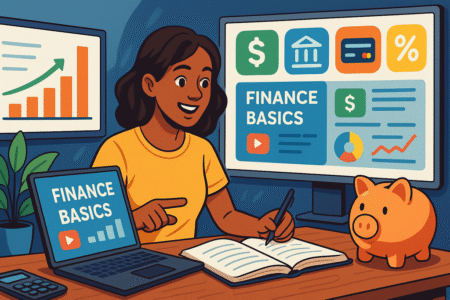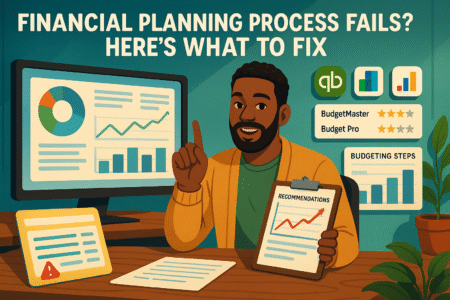Table of Contents
Managing finances doesn’t have to feel overwhelming or confusing. How do you create a budget that sticks, build savings without feeling restricted, or cut down on debt while still enjoying life?
These are the questions many people wrestle with, and the good news is, there are smart, proven strategies that actually work.
In this guide, you’ll find practical tips from experts that you can start using today to get your money under control and working for you.
Build A Realistic Budget You Can Actually Stick To
A budget isn’t supposed to feel like punishment. Think of it as a game plan for your money, showing you exactly where it’s going and how you can redirect it toward things that matter to you.
The key is to create one you’ll actually follow—not one that looks perfect on paper but falls apart in practice.
Track Every Expense To Find Hidden Spending
Before you can fix anything, you need to know the truth. Most people underestimate how much they spend on small, everyday things—coffee runs, app subscriptions, takeout dinners.
I suggest tracking your expenses for at least 30 days. Write everything down, or better yet, connect your bank and credit cards to a tool like Mint so the tracking happens automatically.
Once you’ve done this, patterns emerge. You’ll see categories where money is leaking without you realizing it.
For example, I once had a $12 streaming service I hadn’t used in months but kept paying for. Catching those “invisible expenses” can free up serious cash.
The real trick? Don’t just record your spending—review it weekly. That’s when you’ll spot the hidden habits you can adjust.
Choose A Budgeting Method That Fits Your Lifestyle
There isn’t one “perfect” budgeting method—it depends on how your brain works. If you like structure, the 50/30/20 rule is a classic: 50% of income on needs, 30% on wants, 20% on savings and debt.
If you prefer flexibility, try a zero-based budget, where every dollar gets assigned a purpose (including fun money).
Some people thrive with envelope systems (physical or digital), where categories are separated, and when an envelope is empty, you stop spending. Others prefer high-level tracking with just a few broad categories.
I believe the best budget is the one you’ll actually use consistently.
So experiment. Start with one method, test it for a month, and tweak it until it fits your daily life.
Use Budgeting Apps To Stay Organized And Accountable
Budgeting apps take the guesswork out of the process. YNAB (You Need A Budget) is great if you like assigning every dollar a job—it’s hands-on and keeps you disciplined.
Mint works well if you want automatic categorization and an overview of all your accounts in one place. For simplicity, EveryDollar is clean and easy to navigate.
Most apps let you set spending alerts. That way, when you’re close to overspending in a category, you’ll get a notification before the damage is done. I suggest linking your accounts directly to the app’s dashboard so you’re always working with real-time data.
The other bonus? Apps create visual charts. Seeing your spending broken into categories makes the reality hit harder than numbers alone. It’s like looking in a financial mirror—you can’t ignore what’s staring back at you.
Create A Savings System That Feels Effortless
Saving money doesn’t have to mean cutting every joy out of your life.
The smartest way to save is to make it automatic, invisible, and tied to goals that matter to you.
Automate Transfers To Grow Savings Consistently
Think of automation as removing temptation. If you wait to manually move money to savings, chances are you’ll forget or spend it first. Instead, set up an automatic transfer from checking to savings every payday.
Most banks let you create recurring transfers. For example, move $100 every two weeks into a high-yield savings account. Because it happens before you notice the money is “available,” it feels painless.
In practice, this builds momentum. Even small, regular amounts grow surprisingly fast. A consistent $100 transfer adds up to $2,600 a year—without you lifting a finger after the first setup.
Set Clear Short-Term And Long-Term Savings Goals
Saving just for the sake of saving isn’t motivating. What keeps you consistent is attaching meaning to it.
Short-term goals might be things like building a $1,000 emergency buffer, buying new furniture, or planning a vacation.
Long-term goals could be retirement, a home down payment, or financial independence.
Write your goals down. Even better, label accounts with the purpose: “Hawaii Trip Fund,” “Car Replacement,” “Emergency Savings.” That little reminder makes it harder to dip into the money for something random.
I’ve seen people stick with savings plans much longer once they gave their accounts names. It turns an abstract balance into something real.
Open Separate Accounts To Avoid Mixing Funds
One of the simplest but most effective strategies is to separate your money. If everything sits in one account, it’s easy to lose track of what’s earmarked for bills, savings, or fun.
Consider multiple accounts: a checking account for daily spending, a high-yield savings account for emergency funds, and maybe even separate savings accounts for specific goals. Most online banks make it easy to open additional “sub-accounts” at no cost.
This physical separation makes it harder to spend money meant for savings. When your emergency fund is sitting in a different account, it feels less like extra spending cash and more like a safety net you don’t touch.
Pay Down Debt Using Effective Strategies
Debt is one of the biggest obstacles to financial freedom. It drains your income with interest payments and delays your goals.
The good news? There are proven strategies to pay it off faster and with less stress.
Prioritize High-Interest Debt For Maximum Impact
Credit cards are usually the worst offenders, with interest rates often 20% or higher. That means a $1,000 balance could cost you hundreds in interest if left unpaid.
I recommend targeting these high-interest debts first because they cost you the most over time.
List all your debts, write down balances, interest rates, and minimum payments. Then funnel extra money toward the highest-interest account while still making minimums on the others.
Over time, this approach (known as the avalanche method) saves you the most money.
Try The Snowball Method To Stay Motivated
Sometimes the avalanche feels too slow, especially if your highest-interest debt is also your biggest balance. That’s where the snowball method shines. Here, you pay off your smallest debt first, then roll that payment into the next debt, creating momentum.
For example, if you wipe out a $500 credit card, the $50 you were paying toward it now goes to the next balance. Each win builds confidence and keeps motivation alive.
I’ve seen people stick with debt payoff longer using the snowball, simply because it feels like progress—even if it’s not mathematically the cheapest option.
Consolidate Debt If It Saves You Money
If you’re juggling multiple high-interest debts, consolidation might help. This could mean taking out a personal loan at a lower interest rate or transferring balances to a 0% APR credit card (often available for 12–18 months).
The trick is discipline: consolidation only works if you stop adding new debt. Used wisely, it simplifies payments, reduces interest, and speeds up payoff.
I advise comparing options with an online calculator before consolidating. Sometimes the fees outweigh the benefits, but in the right situation, it can save thousands.
Build An Emergency Fund That Actually Protects You
An emergency fund isn’t just about peace of mind—it’s the financial cushion that keeps life’s unexpected bumps from turning into full-on disasters.
Without one, a car repair or medical bill can send you spiraling into debt.
The goal is to make your safety net strong enough to catch you when life surprises you.
Start Small And Grow Your Safety Net Over Time
If saving three to six months of expenses feels impossible, don’t let that stop you from starting. I suggest beginning with a mini-goal of $500 or $1,000. That’s often enough to handle common emergencies like fixing a flat tire, covering a co-pay, or replacing a broken appliance.
Once you hit that milestone, scale up. Automate a transfer—say, $50 each paycheck—into your emergency fund.
Over time, those small, steady contributions add up. I’ve seen people who thought they could “never save” end up with thousands set aside, just because they let time and consistency do the work.
Think of it like exercise. You don’t run a marathon on day one—you build endurance step by step.
Keep Emergency Funds Separate From Spending Accounts
One of the biggest mistakes I see is people keeping their emergency fund in the same checking account they use for everyday bills. Out of sight is out of mind, and trust me, you don’t want your safety net blending with your latte fund.
I recommend opening a separate high-yield savings account. Many online banks allow you to label the account “Emergency Fund” so you can’t forget its purpose. Because it’s separate, you won’t dip into it accidentally, but it’s still accessible when you truly need it.
That little bit of separation creates a mental barrier. When you log in and see “Emergency Fund: $3,000,” you’ll think twice before spending it on a weekend getaway.
Decide How Much Coverage You Really Need
The classic advice is to save three to six months’ worth of living expenses. But let’s break that down in real terms. Start by adding up essentials: rent or mortgage, utilities, groceries, transportation, insurance, and minimum debt payments. That’s your monthly baseline.
For example, if your bare-minimum monthly expenses are $2,500, a six-month fund would be $15,000.
If you have a stable job and dual income in your household, you might be fine with three months. If you’re self-employed or in an industry with high layoffs, six months or even more is safer.
I believe the right number isn’t universal—it depends on your life situation. The important part is knowing your target and working toward it steadily.
Make Smart Use Of Credit Without Overspending
Credit can be either a powerful tool or a dangerous trap. When used wisely, it builds your score, earns you rewards, and provides flexibility.
When misused, it buries you under interest charges. The trick is learning how to handle credit cards without letting them handle you.
Keep Credit Utilization Low To Protect Your Score
Your credit utilization ratio—the percentage of available credit you’re actually using—has a huge impact on your credit score. The lower it is, the better. I suggest aiming to stay under 30%, though under 10% is even stronger.
For example, if you have a $5,000 credit limit, try not to carry more than $1,500 on it at any time. Even if you pay your balance in full each month, high utilization during billing cycles can ding your score.
A pro tip is to pay down part of your balance before the statement closes so it reports lower.
Think of utilization as a snapshot of how much credit you’re leaning on. Lenders love it when you show restraint.
Use Credit Cards For Rewards But Pay In Full
I love the idea of credit cards working for you instead of against you. Many cards offer cash back, travel points, or perks like extended warranties. But here’s the golden rule: only use them if you can pay off the balance in full each month.
Otherwise, those rewards get wiped out by interest. A 20% APR on a balance will eat through your “free” perks fast.
For example, let’s say you earn $300 in travel points this year. If you’re also carrying $1,000 in revolving debt with 20% interest, you’re paying $200 in interest just to keep that balance. That basically erases your rewards.
Use credit cards as a smart tool, not a crutch.
Check Credit Reports Regularly For Accuracy
Errors on credit reports are more common than most people realize. A wrong balance, an old debt that should’ve fallen off, or even fraudulent activity can drag your score down unfairly.
I recommend checking your credit report at least once a year. In the U.S., you can get free reports from all three major bureaus (Experian, Equifax, and TransUnion) at Annual Credit Report.com. Spread them out every few months so you’re monitoring your credit throughout the year.
If you spot a mistake, dispute it right away. The process usually involves submitting documentation online, and most corrections are resolved within 30 days. Staying proactive protects both your score and your financial reputation.
Invest Wisely To Build Wealth For The Future
Once your debt is under control and your emergency fund is solid, investing is where real long-term wealth begins.
The goal isn’t to get rich quick—it’s to steadily grow your money over decades through smart, diversified decisions.
Understand The Basics Of Stocks, Bonds, And ETFs
Investing can feel intimidating, but at its core, it’s not complicated. Stocks represent ownership in a company, and they tend to be higher-risk, higher-reward.
Bonds are essentially loans you give to companies or governments, usually lower risk but also lower return.
ETFs (Exchange-Traded Funds) are bundles of stocks or bonds that trade like individual shares, giving you instant diversification.
I suggest starting with broad market ETFs, like ones that track the S&P 500. They spread your investment across hundreds of companies, reducing the risk of relying on a single stock.
Think of it like a fruit basket: a stock is a single apple, while an ETF is the whole basket. If one apple goes bad, you’ve still got plenty left.
Consider Retirement Accounts For Tax Advantages
Where you invest is just as important as what you invest in. Retirement accounts like 401(k)s or IRAs come with major tax benefits.
With a traditional 401(k), you contribute pre-tax dollars, lowering your taxable income now. With a Roth IRA, you contribute after-tax dollars, but your future withdrawals in retirement are tax-free.
If your employer offers a 401(k) match, I recommend contributing at least enough to capture the full match. That’s free money you don’t want to leave on the table.
Over time, these accounts supercharge your growth because the money compounds tax-advantaged. Even small contributions today can turn into significant balances decades down the road.
Diversify Investments To Reduce Risk
Putting all your money in one stock—or even one sector—is risky. Diversification spreads that risk. That means owning a mix of asset types (stocks, bonds, real estate, etc.) and regions (U.S., international, emerging markets).
For example, if the U.S. market has a downturn but international markets are growing, your portfolio takes less of a hit.
I believe diversification is less about chasing the highest return and more about protecting your future self. A balanced portfolio means you can weather storms without panicking and pulling money out at the worst possible time.
As you gain confidence, you can fine-tune your mix based on risk tolerance and goals. But at the start, the golden rule is simple: don’t put all your eggs in one basket.
Cut Unnecessary Expenses Without Feeling Deprived
Cutting back doesn’t have to mean living miserably. The goal is to trim waste without stripping away joy, so you free up money for things that actually matter to you.
Audit Subscriptions And Cancel What You Don’t Use
Subscriptions are sneaky. Streaming, apps, memberships—they pile up and quietly drain your bank account. I recommend pulling up your last two months of bank statements and highlighting every recurring charge. You’ll probably find things you forgot about.
For example, I once spotted three music services charging me at the same time because I had tested out different platforms. That was nearly $40 a month I didn’t even notice.
If canceling feels tedious, apps like Truebill or Rocket Money can scan your accounts and let you cancel subscriptions with one tap. That’s instant savings without effort.
Shop Smarter With Discounts, Cashback, And Coupons
Before making a purchase, ask yourself: “Is there a cheaper way to get this?” Many times, the answer is yes. Cashback browser extensions like Rakuten or Honey automatically apply coupons and rebates when you shop online.
For in-store purchases, loyalty apps (like Target Circle or grocery store rewards) often give discounts just for scanning your phone at checkout.
Even credit cards can help. If you’re paying them off in full, using one with cash-back rewards essentially gives you a discount on everything. I suggest treating rewards as a bonus, not an excuse to overspend.
Adopt A “Needs Vs Wants” Mindset Before Spending
A simple but powerful shift is pausing before every purchase and asking: “Do I need this, or do I just want it right now?” That little question slows down impulse spending.
Here’s a trick I use: The 24-hour rule. If it’s not an urgent necessity, I wait a day before buying. Nine times out of ten, the urge passes.
This doesn’t mean depriving yourself. It means being intentional. Spend on what brings real value, cut what doesn’t. Over time, this clarity keeps your budget lean without feeling restrictive.
Plan For Major Life Expenses With Confidence
Big expenses—like buying a home, paying for education, or planning a dream trip—don’t have to catch you off guard.
With smart planning, you can approach them with confidence instead of stress.
Save Early For Education, Housing, Or Travel Goals
The earlier you start, the easier it gets. For education, 529 plans (in the U.S.) offer tax advantages while growing your investment.
For housing, a dedicated high-yield savings account labeled “Down Payment” keeps the goal front and center.
For travel, I like setting up a separate account with automatic transfers so the trip is funded without dipping into daily expenses.
Even saving $100 a month adds up to $1,200 a year—enough to make a real dent in big goals.
Break Down Big Purchases Into Manageable Milestones
Large goals feel intimidating when viewed as one giant number. Instead, break them into chunks.
Say your dream vacation will cost $5,000. That feels huge. But if you save $200 a month, you’ll hit the goal in just over two years. Suddenly, it’s manageable.
Create visual milestones to track progress—like a savings thermometer chart. Watching the numbers climb makes the process satisfying and keeps motivation alive.
Protect Big Plans With The Right Insurance
When planning for major expenses, think about protecting them too. Imagine saving for years for a house, then losing income suddenly. That’s where insurance comes in.
Health, disability, and life insurance can feel like an annoying expense, but they’re really a shield for your long-term plans. For example, life insurance ensures your family can still cover a mortgage if something happens to you.
I advise reviewing your coverage anytime you add a new big goal. Protection makes sure your hard work doesn’t vanish because of an unexpected event.
Use Expert Tools And Resources For Managing Finances
Managing finances becomes much easier when you use the right tools.
These apps and resources streamline the process and give you data to make better decisions.
Explore Popular Budgeting Apps Like YNAB And Mint
YNAB (You Need A Budget) is hands-on. It forces you to “give every dollar a job,” which is great if you like full control.
Mint, on the other hand, automatically categorizes transactions and gives you a snapshot of all your accounts in one place.
If you want simplicity, I recommend EveryDollar. Its clean interface makes budgeting less intimidating. Many of these apps sync directly with your bank, so you don’t waste time entering data manually.
Use Online Calculators For Debt And Savings Goals
Sometimes seeing numbers on paper makes all the difference. Online calculators can show how fast you’ll pay off debt if you increase payments, or how much your savings will grow with compound interest.
For example, plug in a $5,000 credit card balance at 18% interest, then see how much faster you’d be debt-free if you added just $50 more to your monthly payment. That visualization can spark motivation instantly.
Savings calculators work the same way. Watching your money grow over 10–20 years with consistent contributions makes the power of compounding feel real, not abstract.
Follow Financial Blogs And Podcasts For Daily Tips
I believe learning about money should be ongoing, not a one-time event. Blogs and podcasts bring fresh insights and keep you motivated.
For example, The Ramsey Show focuses on debt-free living, while Afford Anything explores financial independence and smart investing. Blogs like Mr. Money Mustache dive into lifestyle shifts that save money in unconventional ways.
The best part is these resources are free and bite-sized. Even a 15-minute podcast on your commute can plant a financial idea that pays off for years.
Stay Consistent With A Long-Term Money Mindset
Managing finances isn’t about quick wins—it’s about building habits you can sustain for decades. A long-term mindset keeps you on track even when life changes.
Review Finances Regularly To Adjust And Improve
Think of your budget like a GPS—it only works if you check your route. I suggest doing a quick monthly review. Look at what went well, where you overspent, and where you can adjust.
Every quarter, do a bigger checkup. Are you on track with savings goals? Is debt going down? Do you need to rebalance investments? Regular check-ins keep you in control instead of running on autopilot.
Celebrate Small Wins To Stay Motivated
Money progress can feel slow, so celebrating small victories matters. Paid off a credit card? Celebrate with a nice dinner—just within budget. Reached $1,000 in savings? Acknowledge it.
This isn’t about splurging, but about reinforcing good habits. Just like fitness, small milestones keep you pushing toward the bigger goal.
Keep Learning To Adapt To Life Changes
Your financial plan isn’t static. Promotions, kids, health changes, or even global events can shift your priorities overnight. A strong money mindset means staying flexible.
I suggest committing to ongoing education. Read a new finance book once a year, try out a podcast, or attend a workshop. The more you learn, the more tools you have to adjust when life throws curveballs.
Consistency isn’t about perfection—it’s about persistence. The people who succeed at managing finances long-term aren’t the ones who never mess up. They’re the ones who keep going, adjusting, and learning over time.






